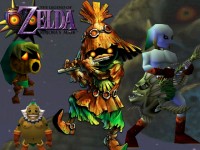 So I have failed you. This will be the first one of these games I review without having completed the game. Part of that is because I moved, some of it was the Mario Kart 8 review that will be on this site sooner or later. Majora’s Mask is a huge game, and with a pretty odd time travel mechanic, it’s a lot of work to see everything. Majora’s Mask is the direct sequel to Ocarina of Time, and has young Link on a journey to find Navi when he is attacked by the Skull Kid. The skull kid has a plan to destroy the world with the moon, and Link must stop him by calling for the help of three guardian spirits. The catch is that Link only has three days to do so, but he is able to restart the three day cycle and retain some of the progress.
So I have failed you. This will be the first one of these games I review without having completed the game. Part of that is because I moved, some of it was the Mario Kart 8 review that will be on this site sooner or later. Majora’s Mask is a huge game, and with a pretty odd time travel mechanic, it’s a lot of work to see everything. Majora’s Mask is the direct sequel to Ocarina of Time, and has young Link on a journey to find Navi when he is attacked by the Skull Kid. The skull kid has a plan to destroy the world with the moon, and Link must stop him by calling for the help of three guardian spirits. The catch is that Link only has three days to do so, but he is able to restart the three day cycle and retain some of the progress.
This makes the game a bit tricky to approach. There aren’t many games in the Zelda series that I feel require a guide for the initial play-through, but Majora’s Mask might need a guide just to keep you from being overwhelmed. The three day cycle is an interesting design choice to play with the linear nature of the Zelda games, at the same time, there’s even more to do. There’s racing mini-games, mini-games that require a visit each day, a fairy collection in each dungeon, and a host of events that require lining up the right day and time to resolve them. There’s even a notebook feature to help you to track who you’ve helped as you go. There’s even a scene where Link fends off an alien invasion of a ranch.
The mask concept itself really changes Zelda’s formula. In addition to getting new gadgets in each dungeon, you’re also getting Masks that transform Link altogether. You get to play in the shoes of Dekus, Gorons, and Zoras, each with their own instruments. Each of the masks gives Link an entirely different set of skills, some novel and others integral to exploration. This is another odd risk, but it allows for more experimentation in the approach to the world than only Link and Epona.
This pokes the edges of the open world concept, as well as playing with linear narratives. This might be Nintendo at its most creative, and there’s a lot of risk to playing with a well worn format. It works in some ways, as this manages to be just as memorable as its predecessor. On the other hand, the time format makes getting through this game maddening in some places. Also, even though the game opens up to playing with time, you’re still being bound to a specific order of the dungeons. Small quibbles with a pretty enjoyable game. Now I’m heading back to finish the game. Next month we have another portable entry in the series.
Tags: Operation All The Zeldas
Written by: Michael McConnell
 So I have failed you. This will be the first one of these games I review without having completed the game. Part of that is because I moved, some of it was the Mario Kart 8 review that will be on this site sooner or later. Majora’s Mask is a huge game, and with a pretty odd time travel mechanic, it’s a lot of work to see everything. Majora’s Mask is the direct sequel to Ocarina of Time, and has young Link on a journey to find Navi when he is attacked by the Skull Kid. The skull kid has a plan to destroy the world with the moon, and Link must stop him by calling for the help of three guardian spirits. The catch is that Link only has three days to do so, but he is able to restart the three day cycle and retain some of the progress.
So I have failed you. This will be the first one of these games I review without having completed the game. Part of that is because I moved, some of it was the Mario Kart 8 review that will be on this site sooner or later. Majora’s Mask is a huge game, and with a pretty odd time travel mechanic, it’s a lot of work to see everything. Majora’s Mask is the direct sequel to Ocarina of Time, and has young Link on a journey to find Navi when he is attacked by the Skull Kid. The skull kid has a plan to destroy the world with the moon, and Link must stop him by calling for the help of three guardian spirits. The catch is that Link only has three days to do so, but he is able to restart the three day cycle and retain some of the progress.
Permalink # Meags
said
Meags
said
I also never finished this game. It was very complicated!